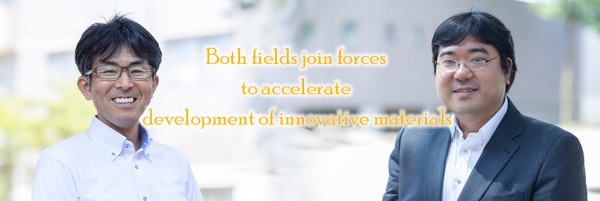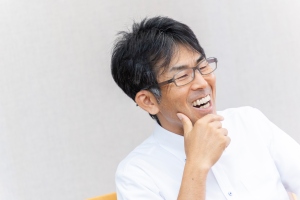ここからサイトの主なメニューです
ここからページの本文です
[Interview Article] Mitsuishi KAZUKI, Field Director

The essence of materials research is "Seeing is believing"
Materials researchers bring in a wide variety of materials in search of information on their "atomic-level microstructure" and "the origin of their properties". "Advanced materials characterization field" boosts the materials development providing measurement and analysis technologies that suits each needs. In April 2023, the Center for Basic Research on Materials was established together with the "Data-driven materials research field" which aims to develop materials based on data-driven data science, and is expected to further accelerate the development of materials. We interviewed Dr. Mitsuishi, Field Director, about the unchanged mission and the future development of the field.
- What do you do in the "Advanced materials characterization field"?
Mitsuishi: To develop materials that have new functions, various methods are taken such as creating complex structures by controlling the process, controlling each individual atoms. While development, the need to know "how such materials actually are" is high, therefore, measurement and analysis technologies are indispensable for the purpose. We are constantly working on to be at the cutting-edge of measurement and analysis technologies necessary for materials development, and developing new techniques to improve the capabilities and expand the range of conditions under which measurements are possible.
In other words, we are a "Group of researchers pursuing cutting-edge measurement and analysis technologies". Our main mission is to develop those and provide it to the development of materials not only in NIMS but also in Japan.
- What kind of measurement and analysis are possible?
Mitsuishi:"Advanced materials characterization field" consists of seven groups: "Electron Microscopy Group", "In-situ Electron Microscopy technique Group", "Nanoprobe Group", "Solid-State NMR Group", "Photoemission Spectroscopy Group", "High Magnetic Field Physics Group", and "Quantum Beam Diffraction Group". For example, the electron microscopy is an instrument that not only visualizes individual atoms but also detects the types of elements. Since there is a need to observe samples in an environment where those materials are actually used, we are also developing an in-situ electron microscopy. As for “Nanoprobe Group”, the nanoprobe is an instrument for observing the surface of materials, but they also controls individual atoms.
The details of these and other techniques are given in the interview with the group leader, but I would like to point out that these technique vary in scale from the microstructure of the material to the macroscopic level. Using these techniques, we can find the structure that originate the material's properties and pinpoint the key areas.
Furthermore, while I believe level of our techniques and equipment are high at this moment, it is also important for us to keep our eyes to the world and constantly catch up with technological development and maintain the level of these techniques.
|
For prospective resarchers
Materials researchers seem to really enjoy working on "their own materials". It is fun to work with them and is very rewarding to support their research. |
 |
- It must be difficult to provide the best measurement and analysis technologies for everything, isn't it?
Mitsuishi: Depending on materials researchers needs, we sometime suggest them to use technologies that are already mature and in some sense commonplace, or in some cases we may provide them to use cutting-edge technologies. Without having both of thse options, we cannot meet the needs of NIMS that develops cutting-edge materials. More importantly, it is not only the equipment that we have in place, but each group has its own trusted experts.
For example, it took me more than 20 years to feel confident as a researcher of electron microscopy and feel that "I can use electron microscopy!". The same is true for other measurement and analysis techniques, where there are researchers like craftsmen who are masters of their techniques. The knowledge of these experienced researchers accelerates the development of materials. At the same time, we are also making efforts to train young researchers so that the succession of technology will not be interrupted.
- You have become one center together with the "Data-driven Materials Research Field" that handles data. What are the advantages of the center?
Mitsuishi: The influence of the recent remarkable development of data-related technologies extends to measurement and analysis technologies. For example, the latest detectors have made it possible to acquire huge data at one measurement. Then, approaches of data science are indispensable to fully utilize those.
The center is made up of researchers in the field of "measurement and analysis technology" and "data science", both of which are not directly involved in materials development. In terms of providing strong support for materials development, I am encouraged by the increase in the number of like-minded researchers who share the same goals. Above all, the fact that we are now in the same center has brought us close together. Now, I have become acquainted with and talk with researchers in data-related fields, including Dr. Sodeyama, Field Director of "Data-driven Materials Research Field".
- What kind of presence do you want the "Advanced Materials Characterization to have?
Mitsuishi: I think the important point is that we are a group of experts in measurement and analysis technologies in a material research institute of NIMS. We need to be a familiar presence for materials researchers, not only in NIMS, so that researchers can feel free to consult with us about their problems regarding materials.
One example is electron microscopy observation in gaseous and liquid environments. Enviroments that used to be difficult to observe samples under such conditions is now technically feasible. Even problems that are thought to be impossible to solve may be made possible as measurement and analysis technologies advances. Therefore, I would like researchers to consult with us first to avoid taking the long way around.
On the other hand, there are times when we are not able to observe the material that researchers bring to us with high expectations. In such cases, we work together with the data science team to find a solution. In some cases, the development of such new methods can lead to world-leading results for us, I would like to proceed having close communication with materials researchers as a unit that supports materials development. First of all, I will try to be a character that is easy for anyone to ask for help.
 |
For Companies
It is our mission to contribute to the revitalization of Japanese industry with our developed measurement and analysis technologies. If you have any problems in materials development, please contact us. Joint research is also welcome. |
Interview & Writing: Akiko IKEDA, Sci-tech communications
Photography: Takahiro MORI
ここからサイトの主なメニューです

